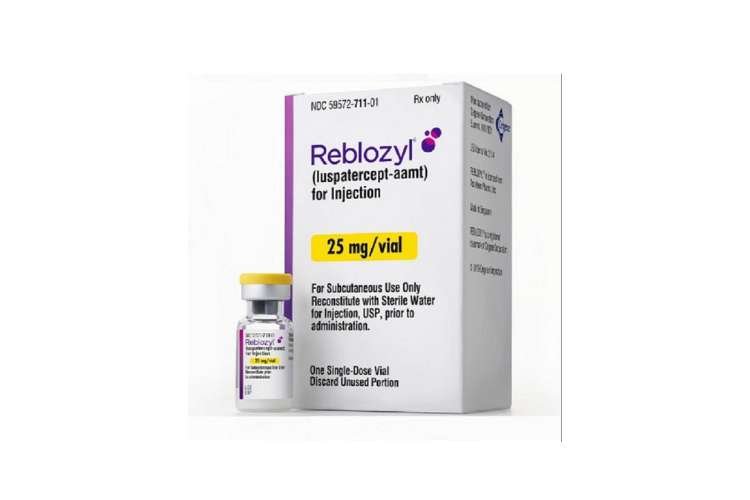Bristol Myers Squibb has ushered in a breakthrough in the realm of medical advancements, announcing the FDA’s seal of approval for Reblozyl (luspatercept-aamt). This green light comes as an avenue of hope for adult patients grappling with very low-to intermediate-risk myelodysplastic syndromes (MDS), marked by anemia. What’s more, these patients have never been exposed to erythropoiesis stimulating agents (ESAs) and often require regular red blood cell (RBC) transfusions.
This news marks a significant stride forward, with Reblozyl now extending its reach to a broader spectrum of patients, as confirmed by the pivotal Phase 3 COMMANDS trial. What exactly is COMMANDS? It’s a scientific saga of a trial, a Phase 3, open-label, randomized study designed to meticulously pit Reblozyl against epoetin alfa, a well-known ESA, in the battle against anemia in low- to intermediate-risk myelodysplastic syndrome patients. The spotlight shines on those who are shackled to RBC transfusions and haven’t tread the path of ESAs before.
Now, brace yourself for the numbers – 58.5% of the Reblozyl-receiving cohort, a robust number of 86 participants, stole the limelight by achieving the primary endpoint. This entails the remarkable feat of enjoying RBC transfusion independence (RBC-TI) for a minimum of 12 weeks, all while experiencing a gleaming surge in hemoglobin levels by at least 1.5 g/dL during the initial 24 weeks of treatment. To put it into perspective, this triumph overshadowed the 31.2% of patients who danced this jig with epoetin alfa, an ESA heavyweight.
“For patients with lower-risk MDS, current standard therapies, including ESAs, have provided limited benefit in controlling anemia with only 1 in 3 patients responding for a duration of 6-18 months. Results from the COMMANDS study showed nearly twice as many patients treated with Reblozyl achieved transfusion independence of at least 12 weeks and concurrent hemoglobin increase compared to epoetin alfa. Today’s approval represents an important advancement for patients with lower-risk MDS.”
– Guillermo Garcia-Manero, M.D., lead investigator and Chief of the Section of Myelodysplastic Syndromes at The University of Texas MD Anderson Cancer Center
Beyond the numbers, what truly strikes a chord is the overarching narrative of how Reblozyl has exhibited its prowess in weaving a tale of efficacy, ultimately transcending the realm of competition. This wonder drug outshone its rival, epoetin alfa, regardless of the intricate ring sideroblast status. What’s this got to do with anything, you ask? Think of it as Reblozyl pulling off a captivating performance on a stage that isn’t set exactly in its favor.
The significance here lies in its ability to venture into the uncharted territory of earlier treatment, addressing the chronic anemia conundrum right at the outset of the journey. It’s akin to a hero that emerges not only when darkness prevails, but also when the first shades of twilight appear, casting a broader protective shadow.
The story unfolds further with the charming twist of the COMMANDS study making its grand entrance. This phase 3 spectacle is an embodiment of scientific rigor, where the protagonists, Reblozyl and epoetin alfa, vie for supremacy in the realm of anemia resolution. Think of it as a thrilling duel, with Reblozyl flexing its muscles as a subcutaneous dose every 3 weeks, while epoetin alfa is no less, administered weekly. The results, oh the results, they weave a narrative of their own.
“Today’s expanded approval of Reblozyl marks an important milestone in our commitment to MDS patients with anemia by providing a durable and more effective treatment option, with more convenient and less frequent administration. We remain dedicated to addressing hard-to-treat diseases with significant burden to patients and look forward to bringing this important option earlier in the treatment process.”
– Wendy Short-Bartie, senior vice president and general manager, U.S. Hematology and Cell Therapy, Bristol Myers Squibb
Enter The Lancet, the canvas where these results are painted. A staggering 58.5% of Reblozyl’s supporters revel in the glory of achieving RBC-TI, a badge of honor that spells independence from transfusions for at least 12 weeks. What’s more, this achievement comes hand in hand with a splendid rise in hemoglobin levels, a testament to the drug’s magic touch.
If that’s not enough to leave you in awe, let’s talk about the erythroid response (HI-E), a marker of victory in this fierce battle. Reblozyl’s flag of triumph flies high at 74.1%, whereas its counterpart, epoetin alfa, manages to gather 51.3% under its banner.
But here’s where the tale takes an even more spellbinding twist. Within the first 24 weeks of the saga, Reblozyl’s devotees aren’t just content with 12 weeks of RBC-TI; they strive for more. A staggering 47.6% plant their feet in the territory of RBC-TI for a glorious 24 weeks, eclipsing the 29.2% that epoetin alfa musters.
For those who seek details beyond the triumphant crescendo, Reblozyl’s advocates exhibit an unwavering commitment to the cause. Their RBC-TI journey stretches over a median of 2.5 years, a testament to the drug’s resolute support in the battle against anemia. However, every saga has its shades of complexity, and this one’s no different. Some common sidekicks that accompany Reblozyl on this journey include diarrhea, fatigue, hypertension, peripheral edema, nausea, and dyspnea.
In the world of science, such accomplishments are not mere lines on a page but chapters in the annals of medical progress. This saga, with its protagonists and their extraordinary feats, was showcased in June at the grand stage of the American Society of Clinical Oncology (ASCO) Annual Meeting and the European Hematology Association (EHA) Congress. It wasn’t just a tale to be told; it was a story that demanded to be etched in history.
What stands out in this intricate mosaic of science and discovery is that the beacon of Reblozyl’s success hasn’t shone solely due to its standalone brilliance. Instead, it’s a product of the collaborative symphony between Bristol Myers Squibb and Merck, two giants that joined hands in November 2021 to write this chapter of medical marvels.





























